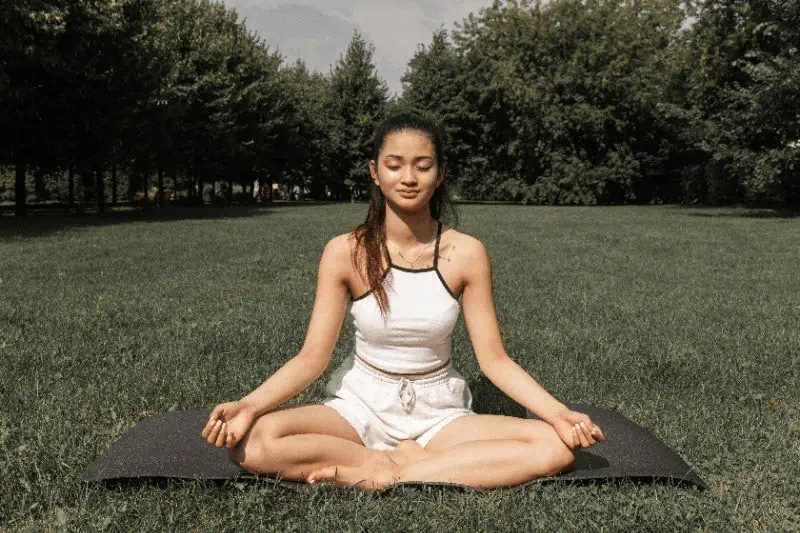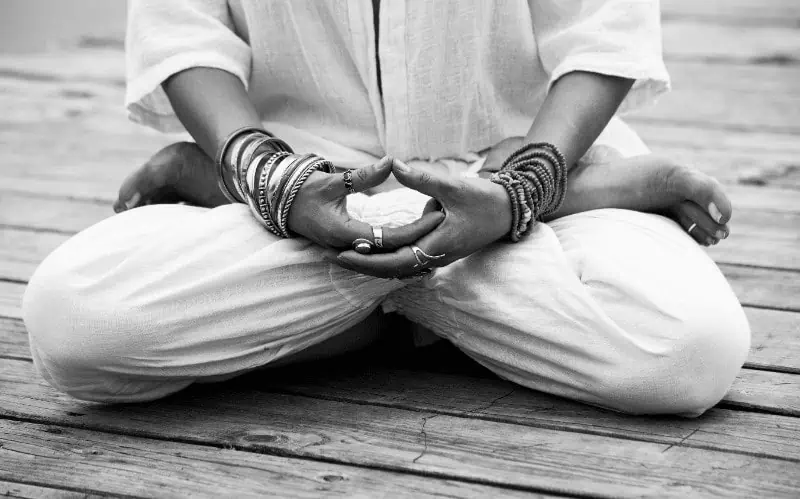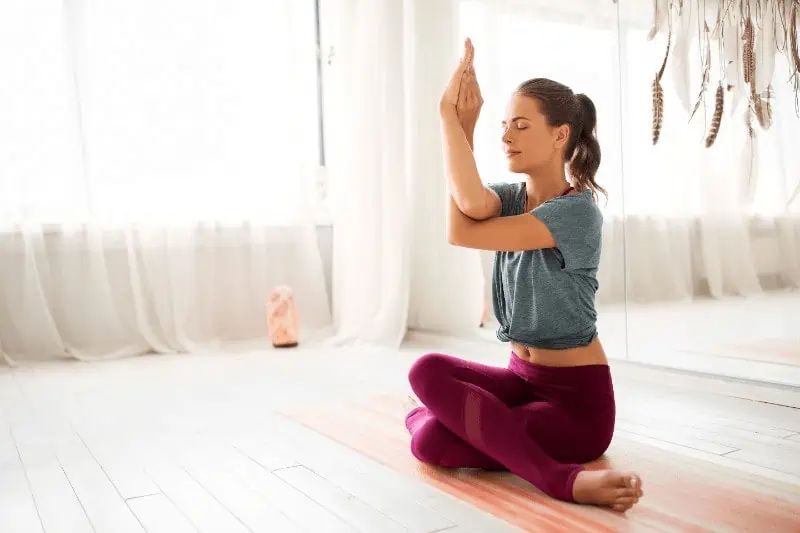As one of the oldest and most influential texts on yoga, the Hatha Yoga Pradipika offers invaluable insights into ancient yogic practices and holds an esteemed place in yogi literature. You might have heard this book called Light on Yoga; the Sanskrit word pradipika means “lamp” or “to illuminate.” Therefore, we understand the goal of this 15th-century Sanskrit text is to shed light on the understanding and practice of Hatha yoga, from its foundational asanas to advanced techniques like awakening Kundalini energy.
The text is not just about physical postures; it delves deeply into breath control (pranayama), internal cleansing (satkarma), energy seals (mudra), and energy locks (bandha). It’s a comprehensive manual for anyone seeking to deepen their practice of Hatha Yoga.
The teachings in the Hatha Yoga Pradipika also extend beyond individual practices. They provide lifestyle guidelines such as cleanliness and moderation, essential for successful yoga practice. Moreover, the insights provided by this haṭha text continue to influence contemporary yoga practices.
You certainly don’t have to be a yoga teacher or guru to study and appreciate these ancient writings. But, you also might not have the time to sit down with the whole book at this moment. Don’t worry! This article aims to give you an overview of the Hatha Yoga Pradipika (HYP), with the goal that your expanded knowledge gives new inspiration to your practice.
Are you ready, fellow yogi? Follow us into the “light” as we explore the Hatha Yoga Pradipika together!
Contents
- 1 Significance of Hatha Yoga in Practice
- 2 Crucial Teachings from Hatha Yoga Pradipika
- 3 Hatha Yoa Pradipika Evolution and Interpretations
- 4 Hatha Yoga Pradipika
- 5 Fundamental Principles of the Hatha Yoga Pradipika
- 6 Comparison with Other Yoga Texts
- 7 Conclusive Thoughts on Hatha Yoga Pradipika
- 7.1 FAQ 1: What is the main purpose of the Hatha Yoga Pradipika?
- 7.2 FAQ 2: What topics are covered in the Hatha Yoga Pradipika?
- 7.3 FAQ 3: Who wrote the Hatha Yoga Pradipika?
- 7.4 FAQ 4: How does studying the Hatha Yoga Pradipika benefit my yoga practice?
- 7.5 FAQ 5: How is the interpretation by Swami Muktibodhananda significant?
- 7.6 FAQ 6: How does the Hatha Yoga Pradipika compare to other yoga texts?
- 7.7 Was this helpful?
Significance of Hatha Yoga in Practice

Physical and Mental Impact
The practice of haṭha yoga, derived from the Sanskrit terms “ha” (sun) and “tha” (moon), greatly impacts the body’s physical and mental well-being and brings balance to your whole system. Many of these physical and mental benefits of practicing yoga are backed by science, including:
- Enhanced physical strength, posture, balance, and flexibility
- Better mental clarity and sense of calmness
- Improved overall mood and reduced stress levels
Spiritual Growth
Hatha is not merely a physical practice — it plays a significant role in spiritual growth, self-realization, and body awareness. Practitioners often experience:
- Enhanced mindfulness
- Deeper connection with their inner self
- Progress towards enlightenment
Relationship with Other Yoga Styles
Haṭha, typically used as an “umbrella” term to include many styles of yoga, shares a close relationship with other styles.
Raja Yoga incorporates haṭha practices into its eight-fold path towards enlightenment. Traditionally, Haṭha yoga served as a preparation, a sort of stepping stone toward the deep meditative practice of Raja Yoga.
The HYP also mentions Kundalini Yoga, another popular style, which focuses on awakening dormant energy through specific poses and energetic practices.
Influence on Modern Practices
Modern yoga practices worldwide owe much to hatha. In fact, many popular styles, such as Vinyasa, have roots in haṭha yoga.
Beyond the physical body, Hatha’s emphasis on breath control and meditation is widely recognized today, as it lays the foundation for modern mindfulness and stress management techniques.
In essence, the significance of haṭha (hatha) yoga in practice spans physical health, mental well-being, and spiritual growth. It shares a close relationship with other yogic paths like Raja and Kundalini, and its influence on contemporary yoga practices is undeniable.
Crucial Teachings from Hatha Yoga Pradipika
The Hatha Yoga Pradipika serves as a detailed and informative guide for practitioners of haṭha yoga, providing a roadmap to holistic wellness and spiritual growth. The ancient Sanskrit text offers insights in four chapters: asana (postures), satkarma and pranayama (purification and breathing techniques), mudra and bandha (energetic seals and locks), and samadhi (enlightenment).

Chapter 1: Asanas in Detail
The first chapter focuses on asanas. The haṭha text details 15 specific postures that help control energy flow and prepare the body for seated meditation. The included poses consist of seated, standing, and relaxation postures. This chapter of the book outlines the purpose, benefits, and instructions for each asana.
Aside from introducing essential yoga poses, the HYP also provides valuable instructions for setting up successful asana practice. Some of its lessons include:
- The importance of a calm and quiet environment, free from distractions, allowing the practitioner to concentrate fully.
- There is a need for regular and consistent practice, with gradual progression in the complexity of the asanas.
- Personalized practice based on individual capacity and comfort emphasizes that the goal of yoga is not just physical fitness but also mental and spiritual well-being.
Chapter 2: Satkarma and Pranayama Insights
Satkarma refers to six acts of purification designed to cleanse and purify the body in preparation for pranayama. Removing toxins and impurities from your body will improve your physical well-being and help you get the most out of your Hatha practice.
pranayama, a crucial part of haṭha, involves breathing exercises to control the flow of prana, the vital life force coursing through the body. The book introduces different types of pranayama, explaining the benefits of each technique as well as instructions for how to practice them.
Some of these techniques include:
- Ujjayi, or “victorious breathing,” commonly used in yoga breathing exercises
- Sitali or “cooling breath”
- Kapalabhati or “breath of fire”
- Bhramari or “bumblebee breathing”
To learn about more breathing techniques like these, visit ourPranayama guide!
Chapter 3: Mudras and Bandhas Unveiled
Mudras are specific hand gestures or positions performed with the hands and fingers. Typically, they are used in yoga and meditation to either direct or seal energy in the body or stimulate specific areas of the brain.
Examples of mudras include:
- Gyan Mudra (knowledge gesture)
- Anjali Mudra (salutation gesture)
- Prana Mudra (life force gesture)
Bandhas, or energy locks, are used to control the flow of prana throughout the body. There are three main bandhas:
- Mula Bandha (root lock, located at the base of the spine)
- Uddiyana Bandha (upward abdominal lock)
- Jalandhara Bandha (throat lock).
These seals and locks are used to conduct or hold prana in certain areas and redirect it for specific purposes, such as rejuvenating the body and mind and intensifying spiritual growth. Incorporating mudras and bandhas into your practice can enhance yoga’s physical, mental, and spiritual aspects, promoting healing and inner peace.
Chapter 4: Samadhi Explored
Finally, the last chapter of the text discusses the attainment of samadhi, the highest state of consciousness, by means of various meditative practices. According to the HYP, some of the specific methods used to facilitate spiritual awakening include:
- Divine sound (nada) meditation: Encourages practitioners to close their ears to external distractions and instead concentrate on the “inner” sound to quiet the mind and cultivate tranquility.
- Meditation on Bindu: Another form of deep concentration in which one focuses on a small dot representing the union of all consciousness.
- Awakening Kundalini energy: Removing blockages that allow this energy to flow through the spinal channel leads to spiritual awakening.
Along with these meditative techniques, this final chapter of the HYP offers encouragement in dealing with common obstacles such as distractions and restlessness. It emphasizes the importance of regular practice and a dedicated enthusiasm toward the attainment of samadhi.
Hatha Yoa Pradipika Evolution and Interpretations
The Hatha Yoga Pradipika, written by the yoga guru Svatmarama, dates back to the 15th century. As a renowned teacher, Svatmarama is an influential figure in the evolution of Hatha Yoga. His work provides a model for establishing a meaningful yoga practice and serves as a guiding light for generations of yogis.
Over the centuries, the original Sanskrit text has been translated into numerous languages, making it accessible to a global audience. Consequently, the book has evolved along with the times, with various interpretations and translations enriching its teachings.
Swami Muktibodhananda’s Commentary
One of the most notable modern translations of the Hatha Yoga Pradipika is by Swami Muktibodhananda, who brought the work of Svatmarama to the Western world. Her interpretation and commentary are widely appreciated for their clarity and depth, enabling students to understand and apply the principles of Hatha Yoga in their modern-day lives.
Swami Muktibodhananda’s translation delves into the Sanskrit verses of the text and provides more detailed explanations of concepts like satkarma, chakras, and the subtle energies of the body that contribute to spiritual awakening.
In addition to expanding upon the original ideas of the HYP, Swami Muktibodhananda’s interpretation emphasizes:
- Cultivating a balance between effort and relaxation when practicing yoga
- The goal of achieving the union of body and mind
- The role of prana, breath work, chakras, and Kundalini as means for reaching a higher state of consciousness.
Throughout her work, Swami Muktibodhananda uses contemporary language to convey profound concepts, making the ancient wisdom of the Hatha Yoga Pradipika more accessible to modern yogis. No matter where you are in your yogic path, this is an essential title to add to your collection of yoga books—also some more books for reference.! Pick up a copy here.

Hatha Yoga Pradipika
See latest priceFundamental Principles of the Hatha Yoga Pradipika

Balancing Energies
In yoga philosophy and Ayurveda (the sister science of yoga), the nadis are integral to the body’s energetic system. Nadis are described as the energetic channels through which life force, or “prana,” circulates within the body.
Balancing the nadis is crucial, as any blockage or imbalance in these energetic channels can lead to physical, mental, or spiritual health issues. When prana flows freely through the nadis, it promotes a state of well-being within the body. On the other hand, a disruption in this flow can bring disease, discomfort, or emotional unrest.
Hatha yoga works towards balancing energies within the body through:
- Āsanas (Postures): Promote control over the physical body.
- Pranayama (Breathing Exercises): Controlling the breath to achieve a balance between ‘ha’ (sun) and ‘tha’ (moon) energies.
- Bandhas (Locks): Channel energy flow within the body.
Practicing yoga, meditation, and pranayama are often recommended to cleanse and balance the nadis. These practices encourage the free flow of prana, supporting good health, vitality, and a sense of inner peace.
Discipline and Consistency
The Hatha Yoga Pradipika offers a model for achieving success in your yogic journey, which requires dedicated and consistent practice. It reminds practitioners that the fruits of yoga — clarity of mind, physical strength, and spiritual growth — emerge gradually through persistent effort.
To help maintain discipline in your Hatha yoga practice, the HYP suggests:
- adhering to the ethical guidelines of the Yama and niyama
- detaching from worldly desires and limiting distractions
- focusing on gradual progress rather than overnight perfection
- receiving guidance from a qualified guru (teacher)
Remember: enlightenment doesn’t happen right away. As the saying goes, “Yoga is a practice, not a perfection.” The Hatha Yoga Pradipika reminds us that it is only through consistent effort and commitment that one can truly unlock the transformative power of yoga.
Comparison with Other Yoga Texts
Hatha Yoga Pradipika vs Patanjali’s Yoga Sutras
While yogis everywhere revere both the Hatha Yoga Pradipika and Patanjali’s Yoga Sutras, the presentation of their content differs greatly. The former is more practical in nature, focusing on the physical aspects of yoga, such as postures (asanas), breath control (pranayama), energy locks (bandhas), and purifications (ṣaṭkarma). It provides a tangible guide for hatha yoga practitioners.
On the other hand, Patanjali’s Yoga Sutras delve deeply into yoga’s philosophical and psychological dimensions. This book emphasizes ethical disciplines (yamas and niyamas) and meditative practices.
Comparison with Similar Works
In comparing the Hatha Yoga Pradipika with other texts like the Gheranda Samhita and Shiva Samhita, several similarities stand out: the emphasis on purification techniques, detailed posture descriptions, and pranayama’s importance.
However, each of these books offers its own unique insights into the practice of Hatha Yoga. Here are some general distinctions between the three texts:
- Hatha Yoga Pradipika: Places a stronger focus on practical aspects of yoga, incorporating some philosophical and spiritual insights.
- Gheranda Samhita: Similar to the HYP in its practical application of yoga, but delves more into purification techniques and different mental and spiritual practices.
- Shiva Samhita: Emphasizes the relationship between teacher and student and explores the nature of the self and reality.
In essence, while the Hatha Yoga Pradipika draws from shared knowledge within the space of yogic literature, it also carves out its own niche by providing specific instructions for hatha yoga practitioners seeking enlightenment.
Conclusive Thoughts on Hatha Yoga Pradipika
The Hatha Yoga Pradipika endures through time as an essential guide for yogis everywhere. Its teachings, interpreted and conveyed by revered teachers like Swami Muktibodhananda and Svatmarama, provide a comprehensive understanding of Hatha Yoga principles. The text’s specific approach sets it apart from other works, offering detailed insights into the methods and philosophy of Hatha Yoga.
The lessons in this ancient text serve as reminders that yoga is not just about mastering poses or attaining perfection; it’s about embracing a holistic lifestyle that harmonizes body, mind, and spirit.
So why wait? Dive deep into the wisdom of the Hatha Yoga Pradipika and embark on a transformative journey today!
FAQ 1: What is the main purpose of the Hatha Yoga Pradipika?
The Hatha Yoga Pradipika essentially provides a model for practicing Hatha Yoga. Beyond teaching specific techniques, it offers encouragement for overcoming common obstacles and maintaining consistency in practice.
FAQ 2: What topics are covered in the Hatha Yoga Pradipika?
This historical work includes detailed explanations of various asana (poses), pranayama (breath control), chakras (energy centers), kundalini (spiritual energy), nadis (energy channels), mudras (gestures), and bandhas (locks).
FAQ 3: Who wrote the Hatha Yoga Pradipika?
The Hatha Yoga Pradipika is attributed to Svatmarama, a yogi and teacher from 15th-century India.
FAQ 4: How does studying the Hatha Yoga Pradipika benefit my yoga practice?
Studying this text provides profound insights into traditional yoga practices beyond physical postures. It offers meditation, energy control, ethical living, and spiritual awakening guidance.
FAQ 5: How is the interpretation by Swami Muktibodhananda significant?
Swami Muktibodhananda’s interpretation provides modern readers with clear explanations of complex concepts in an accessible language.
FAQ 6: How does the Hatha Yoga Pradipika compare to other yoga texts?
While all yogic texts offer valuable insights, the Hatha Yoga Pradipika is unique as it provides detailed instructions on physical postures and techniques for controlling energy flow, making it a practical guide for yogis.


